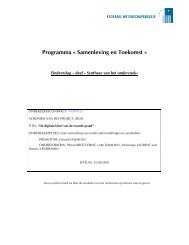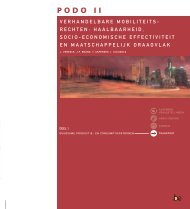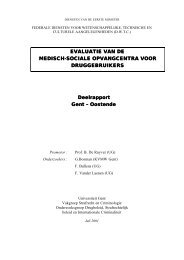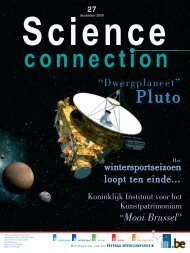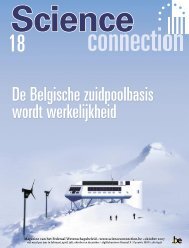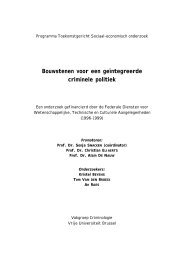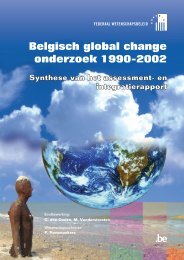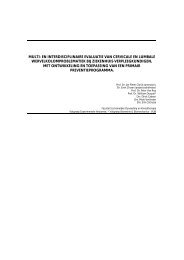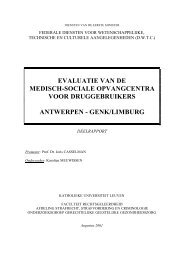chapter 3 inventory of local food systems
chapter 3 inventory of local food systems
chapter 3 inventory of local food systems
You also want an ePaper? Increase the reach of your titles
YUMPU automatically turns print PDFs into web optimized ePapers that Google loves.
Project CP/59 - “Instruments and institutions to develop <strong>local</strong> <strong>food</strong> <strong>systems</strong>”<br />
In a similar way, we calculated the carbon dioxide emissions (see table 3) for the<br />
different <strong>food</strong> items, resulting in comparable trends as seen in the energy results: in <strong>local</strong><br />
<strong>food</strong> <strong>systems</strong> the highest total values are for cheese (2399 g CO2/kg), the lowest for<br />
apples (77 g CO2/kg) and in-between values for vegetables and beef. In the mainstream<br />
system all figures are lower, but with also the highest value for cheese (1833 g CO2/kg),<br />
the lowest for apples (67 g CO2/kg).<br />
When looking at the total carbon dioxide emission per portion, cheese has the highest<br />
emission rates for both the <strong>local</strong> and the mainstream system, even though cheese<br />
accounts for a portion <strong>of</strong> only 15 g, compared to e.g. 200 g for potatoes.<br />
When comparing transport energy uses and CO2 emissions per kilogram on the one side<br />
to processing and storage energy uses and CO2 emissions per kilogram on the other side<br />
(table 2 and table 3), almost all data for processing and storage are lower than for<br />
transport, except apples, both <strong>local</strong>ly sold and through the mainstream system, and<br />
cheese in the mainstream system. Apple storage uses more energy and emits more CO2<br />
both in the <strong>local</strong> and the mainstream <strong>food</strong> <strong>systems</strong> because <strong>of</strong> the long storage period<br />
(up to 10 months in ULO-refrigeration ). Cheese in the MFS consumes more energy and<br />
emits more carbon dioxide during storage than in LFS, as the production process in this<br />
study is the same for <strong>local</strong> and mainstream <strong>food</strong> <strong>systems</strong>. This is mainly because <strong>of</strong> the<br />
longer total storage time due to longer storage at each step in the mainstream <strong>food</strong><br />
chain.<br />
2.5.3. Discussion<br />
We are aware <strong>of</strong> the sensitivity <strong>of</strong> our results to assumptions (see annex), as a lot <strong>of</strong> the<br />
data are difficult to obtain in exact figures and as this study is based on a small number<br />
<strong>of</strong> specific case studies. Although by using the same methodology for the <strong>local</strong> and the<br />
mainstream <strong>food</strong> <strong>systems</strong>, this sensitivity to assumptions can be largely reduced by<br />
comparing the relative differences between these two <strong>food</strong> <strong>systems</strong>. In addition, there<br />
can be large differences between similar LFS and there are some side effects outside<br />
these system boundaries <strong>of</strong> the basic simulation (full summer and inland production)<br />
presented in the results that have a non negligible impact on the total energy<br />
consumptions and on the total carbon dioxide emissions <strong>of</strong> a specific <strong>food</strong> item. These<br />
side effects are: the transport efficiency <strong>of</strong> the consumers’ purchase <strong>of</strong> <strong>food</strong>, the transport<br />
efficiency <strong>of</strong> the transport mode for imports from abroad, and production in greenhouses<br />
versus in open air. Finally, it is also complicated to compare the absolute levels <strong>of</strong><br />
energy uses and carbon dioxide emissions <strong>of</strong> this study with other studies because <strong>of</strong> the<br />
differences in system boundaries, calculating methods etc.<br />
Variation between existing <strong>food</strong> <strong>systems</strong><br />
Even though the selected case studies are representative for the present LFS in Flanders,<br />
there can still be a large variation between LFS <strong>of</strong> the same kind. For instance there is a<br />
relative difference in energy use for transport <strong>of</strong> 1 over 9 between two investigated<br />
farmers selling their apples through farmers markets and <strong>of</strong> 1 over 13 for the energy uses<br />
<strong>of</strong> storage <strong>of</strong> two other farmers. Probably these differences are also to be found in other<br />
<strong>systems</strong> such as box schemes. The main causes for these large differences are<br />
SPSD II - Part I - Sustainable production and consumption patterns - Agro-Food 43



